Why Speed Matters More Than Ever
In 2025, nobody waits for a slow website. Visitors expect your page to load in seconds — or they’ll bounce. On top of that, Google ranks faster sites higher, so improving speed doesn’t just please your users, it can boost your search visibility too.
The best part? You don’t need to start from scratch. With a few smart changes, you can speed up your site dramatically.
7 Practical Ways to Boost Your Website Speed
1. Optimize Your Images
Large images are often the #1 reason websites load slowly. You can fix this quickly by:
- Compressing them using TinyPNG, Squoosh, or ShortPixel
- Switching to WebP, a modern image format that loads faster than JPEG or PNG
It’s one of the fastest wins for site performance.
2. Use a Content Delivery Network (CDN)
A CDN stores copies of your website on servers around the world. So when someone visits, they’re served your site from the closest location — not from halfway across the planet.
Top options include:
- Cloudflare
- BunnyCDN
- Amazon CloudFront
If your audience is international (or growing), a CDN is almost a must.
3. Enable Browser Caching
When someone first visits your site, their browser downloads your images, stylesheets, and scripts. With caching enabled, their device saves these files — so on future visits, pages load almost instantly.
- WordPress users can enable this with caching plugins.
- Otherwise, you can set it up manually in your
.htaccessor server config.
It’s a small change that delivers huge speed benefits.
4. Minify CSS, JavaScript, and HTML
“Minifying” means removing unnecessary spaces, comments, and formatting in your code. It cuts file sizes so browsers can load them faster.
Use tools like:
- Minifier.org
- Autoptimize
- WP Rocket
Most sites see noticeable gains right away.
5. Upgrade Your Hosting
If you’re on a cheap shared hosting plan, your site might slow down when traffic spikes. For better performance, look into:
- Cloud hosting
- Managed WordPress hosting
- VPS (Virtual Private Server)
Quality hosting makes your site faster, safer, and more reliable.
6. Reduce or Replace Heavy Plugins
Especially on WordPress, too many plugins (or poorly coded ones) can drag down performance.
Quick tune-up:
- Deactivate plugins you don’t truly need
- Swap bloated plugins for lightweight options
- Always keep everything updated
Fewer, smarter plugins = faster site.
7. Add Lazy Loading for Images & Videos
Lazy loading means images or videos only load when they’re about to appear on the user’s screen. That way, your page shows up faster without waiting for everything below the fold.
Many themes and performance plugins now have this built in.
Check Your Progress
After you’ve made changes, test your speed. Try:
- Google PageSpeed Insights
- GTmetrix
- Pingdom
- Lighthouse (built into Chrome DevTools)
These tools give you hard numbers — and often pinpoint other areas you can tweak.
Final Thoughts
Website speed is more than a technical metric. It shapes how users feel about your brand — and whether they stick around.
Start with quick fixes like compressing images, enabling caching, and choosing better hosting. Then add a CDN, lazy loading, and minification to layer on more speed.
A faster site means happier visitors, better search rankings, and more results from the traffic you already get.


